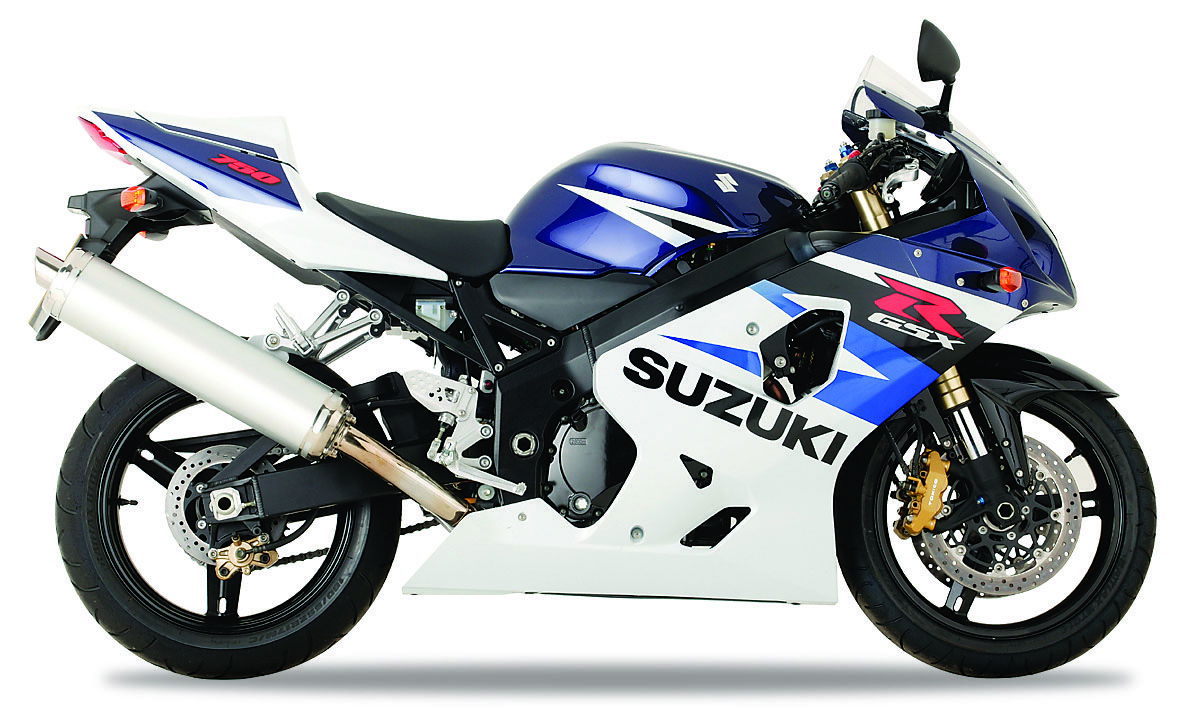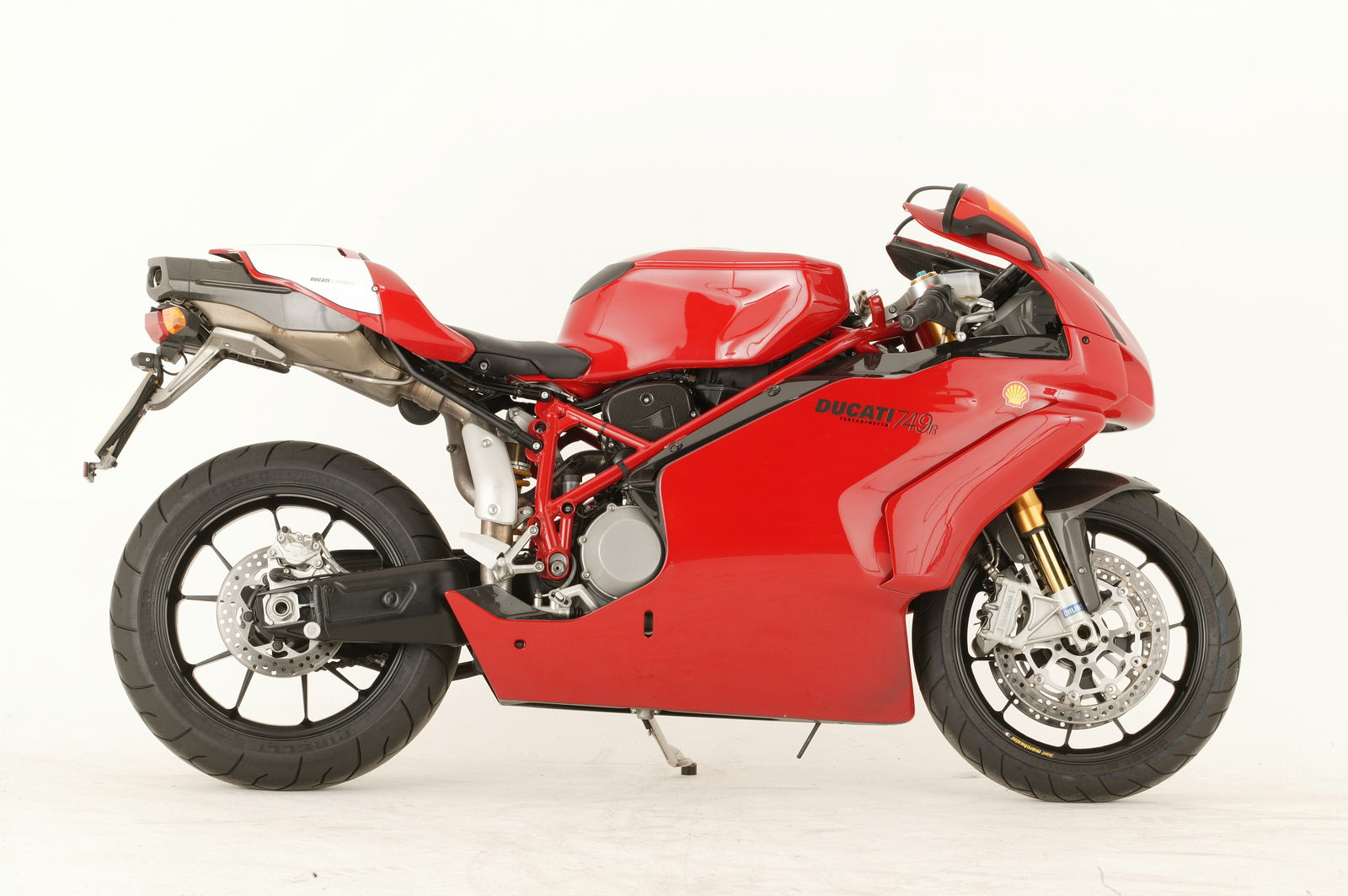2004 GSX-R600 K4 review
While the engine is flexible, strong and useful, the 2004 GSX-R600 K4 will appeal to a certain type of rider; one that likes to make engines scream, change gear at every corner and work the bike hard.

THE INSTANT I set eyes on Suzuki's first GSX-R600 at the 1996 NEC show I was smitten. Seven years and three major upgrades later, the 2004 GSX-R600 K4 is a sophisticated beast, with a fuel injected 599cc titanium-valved motor, radial brakes, brand new chassis and upside down forks.
I remember the GSX-R600 V (that I sold my first born to Black Horse Finance in January 1997 for) as a raw, howling two-stroke-alike, minus the smell of Castrol oil and ring-ding-ding. The handling was awesome, but you might as well have got off to push if you didn't keep the four-stroke, carburetted motor in its 10,000rpm sweet spot.
August 2004
This 600cc now has acres of midrange and is much more forgiving and easy to ride than its predecessor, the 1997 GSX-R600. The K4 flatters clumsy riding where the V would punish it - on the V, get in too high a gear and you'd be greeted by sweet nothing as you open the throttle. Instead, the K4 continues to pull, bailing you out with a sexy midrange snarl from the airbox.
The fuel injection is smooth throughout the relatively strong powerband (which on the V was thinner than a flee's pubic hair), even at small throttle openings - that'll be the Suzuki Dual Throttle Valve's secondary valve doing its job then.
I already know all this because I spent four days riding a GSX-R600 K4 at Jerez with 100% Bikes (www.100pc.co.uk), before taking delivery of my longtermer. Confidence in my new bike is sky high. It doesn't take me long to run it in: 600 miles of fairly restrained riding, a quick first service and I head straight to Brands Hatch for a track day. But it all goes horribly wrong after a fantastic first few sessions - I lose it coming out of Clearways. Oops!
Back in the pits, I remove gravel from the fairing, give it a good clean and inspect the damage. To my amazement, the GSX-R got away with gravel rash on the fairing, bar end and lever - the bendy indicators folded in nicely!
I get back in the saddle and continue to ride my GSX-R all afternoon, and even take it to Silverstone GP circuit with 100% Bikes the following weekend - but not before fitting double hard mushrooms (£39.99), bar ends (£14.99) and engine protectors (£39.99) from Motrax, (01933) 418414 - better late than never! And for the final May bank holiday I take off to Valencia circuit in Spain with Byrne-Up, www.byrne-up.co.uk, (0871) 7174141.
I love foreign track days. You get plenty of time to take it easy and learn where you're going, and the atmosphere is so chilled compared to UK events. I've been touring French and Spanish tracks with Byrne-Up for years now - they were the first people to organise European track day tours - and I know this is the best way to restore my lost confidence.
And it works. I finally bond with my new bike. Valencia is a twisty circuit and the GSX-R loves it: it turns sharp, holds a tight line and feels planted. I was a bit disappointed to see an unadjustable steering damper hidden under the top fairing, but the bike is so agile I soon forget it's there. I remember experiencing my first tankslappers on the old V model!
More recent years of riding the R6 and its clunky gearbox made me forget how sweet the GSX-R's gearbox is. I learned clutchless upshifts on my V and it's just as smooth and seamless on the K4.
But the K4's brakes are from a different planet. The V's weedy four-pot regular calipers were never really up to standard. Instead, the K4 has state-of-the-art radial stoppers that let you brake later than Bertie's Slimmer Of The Week award is in coming. But this did provoke front wheel patter - probably down to the soft front forks bottoming out.
Last year with my R6, I discovered the best thing you can do to sort a bike is upgrade the suspension - one area I'll be attacking on my GSX-R600 K4. But first, I need to sort cosmetics. I'll try to repair the scraped OE fairing, but I'll also get aftermarket fairings and give it a nice paint job while I'm at it - I'm not keen on the black and orange scheme. And after the suspension, it'll be time to get serious with fuelling and weight.
I may not have got off to the best of starts with my GSX-R600 K4 longtermer (it's me, not you - honest). But things can only get better, right?
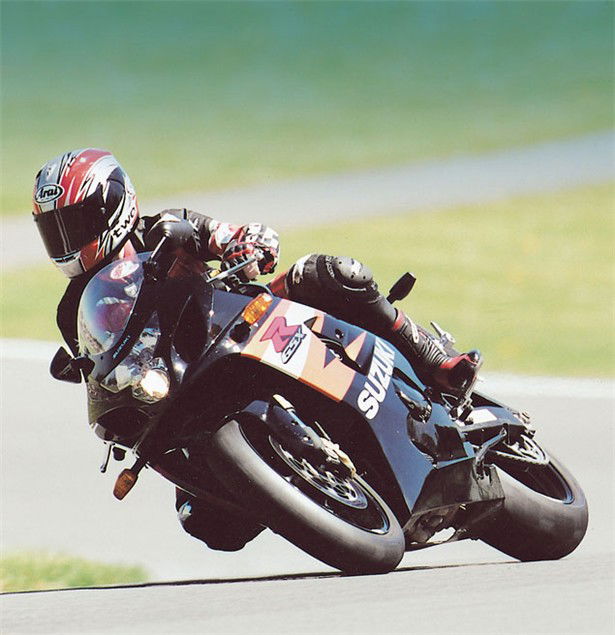
November 2004
The standard suspension on my Suzuki GSX-R600 is soft. Too soft. It also feels very high at the back - especially for my measly eight-and-a-half stone - with too much weight over the front, which would be fine if the suspension were high enough quality to control it. But it bounces around like Zebedee on speed and the fork legs patter under hard braking. I'm certain I can improve on the set-up just by using the standard suspension's adjustment.
Production suspension is built down to a price and to cater for a wide range of riders and conditions, so it will always be outshone by aftermarket kit. For starters, the adjustment range of a high quality unit is finely tuned so each click of the adjustors will make a difference, which isn't the case with production components. But there is still a range to play with, so I get Colin from 100% Bikes Suspension (0870) 8722532 to have a tweak during a 100% Bikes track day.
First of all Colin looks at the attitude of the bike, determined by the static sag - i.e. not a Chinese dish but the amount the suspension compresses under the bike's own weight before a load (rider/braking force) is applied. It's the baseline setting to get right before any other adjustment, and it's done by turning the preload adjusters. What you're looking for is that there isn't too much weight on the front, too little on the rear or vice versa.
My GSX-R has a front sag of 27mm, where a static sag of between 20-25mm is better suited to a 600. So Colin sets it at 23mm. Next, we measure the rear, which at 4mm is not sagging enough. The rear should be between 5mm and 8mm, so Colin sets it at 6mm. As I suspected, there was too much weight over the front so this was addressed.
Because we adjusted the preload to change the static sag and thus the spring action, we now need to adjust the damping. Compression damping controls the speed the spring compresses under load - accelerating, braking or hitting bumps. Too much and the bike becomes harsh, too little and it'll pogo. Rebound damping controls the speed your springs bounce back after being compressed. Without it your bike would bounce you off the saddle with every bump; too much and your springs won't fully recover between compressions, resulting in squat and awful handling.
At the front, Colin increases compression damping by turning the adjuster from 1.75 (turns out from full in) to .75, and increases rebound from .75 to .33. On the rear, Colin increases compression damping from 2.75 (turns out from full in) to 1.75, while rebound damping is reduced from 2 to 2.25.
So the bike is better balanced and the suspension is firmed up, but it's still compliant. Many riders worry their bike might become rock hard if they touch their suspension, but that's not the case with production kit. It simply becomes more controlled and gives better feel. The GSX-R's has also lost that 'front-endy' feel and the set-up is better suited to track and road. The front-end patter is noticeably better but not completely cured - for this the forks will need stiffer springs.
Better controlled suspension also improves grip from your rubber, as tyres are left to tract the road rather than struggle to control bouncing suspension.
I've done several track days this year, the excuse being to practise for my MiniTwins race. So I've been running Metzeler Rennsports for ultimate road-legal grip on a race track. Whenever I've used Rennsports on a dry surface I've never had a 'moment'
I could blame on the tyres (and no, I wasn't running Metzelers when I had my Brands off!). So when the Rennies were superseded this year by Racetecs, I had to give them a go - and did so during a hot track day in France. I knew as soon as I fitted the Racetecs I was running something special. The profile feels steep for road rubber and you really notice the GSX-R dropping sharply into corners. And the confidence you gain from the sheer amount of grip is impressive.
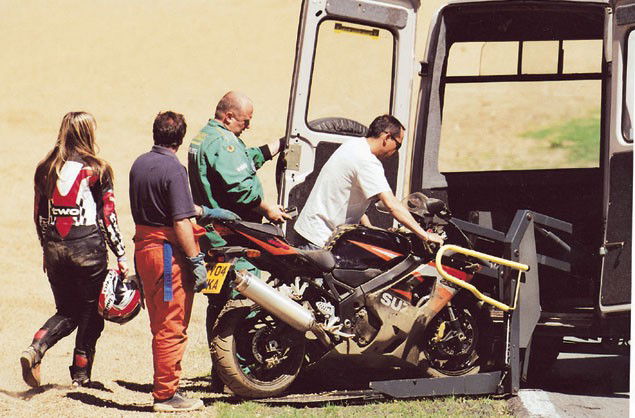
February 2005
Six days at Nogaro, four days at Jerez, two days at Valencia, three days at Lédenon, two days at Val de Vienne, one day at Croix en Ternois, two days at Magny Cours and two days at Catalunya. That's the total of foreign track days I rode my fabulous Suzuki GSX-R600 K4 at since getting it back in April. It's been the best biking season of my life spent with the best bike I've ever owned.
Of course, I almost spoilt it in June when I binned my GSX-R round Brands Hatch's Clearways - my long and busy season's only mishap, I hasten to add.
Fortunately, aside from my ego the only damage was a very scratched right hand fairing; the plastic wore so thin in parts there were gaping holes! I was gutted, especially as I'd just got the GSX-R looking really good with an ultra-cool undertray from Ermax complete with flush mini-indicators (which an advanced riding instructor who took me for an observed ride one Sunday disapproved of mightily), the obligatory smallish number plate from MAL and a carbon fibre rear hugger complete with chain guard from NWS. OE fairings cost a mint so I was on the brink of trawling eBay when an ad in TWO's back pages for Plastec Motorcycle Paintwork & Design caught my eye. As well as doing all kinds of airbrushing and custom paintwork, these dudes repair damaged fairings and tanks. I reckoned they wouldn't be able to do much with my shredded fairing but couldn't believe it when, just a few days after sending the GSX-R's fairing to their Reading workshop, it came back looking better than new! The finish is more immaculate than a touched-up boob in FHM with no trace of any scars. The difference is that instead of Suzuki's cheap stickers the artwork is professionally lacquered on, and for a fraction of the cost. Result.
You'll probably remember me not liking the GSX-R's blackness and orangeness. I changed my mind (Well, I AM a woman). The cosmetic bits and pieces make a huge difference and it now looks proper mean in its moody colour scheme. But what really makes the difference is the sleek Titanium Yoshimura Tri-Oval end can, which I didn't just choose because it's the coolest thing out there. I'll explain...
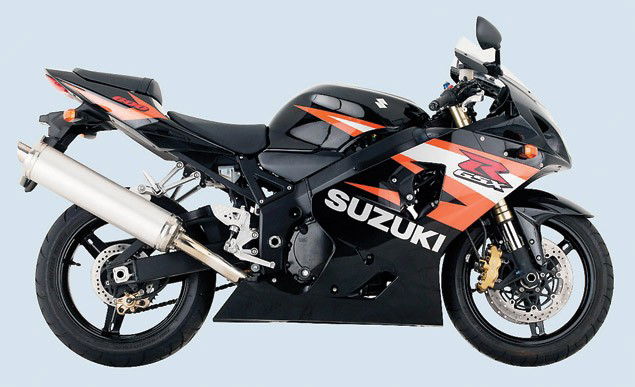
Despite the power feeling surprisingly strong in the mid-range, the dyno showed the GSX-R peaking at just 98bhp, which is somewhat underpowered compared to the opposition. In TWO's November 2004 issue we tested a load of end cans using my GSX-R as a guinea pig. As you'd expect, most added a bhp or two, and even three in the Micron's case. But the Yoshi liberated a whopping 5bhp, bringing power up to 103.2bhp. Yoshimura work with the Suzuki race teams and a lot of their R&D is done on the GSX-Rs, so it isn't surprising really. The Yoshi also weighs a mere 1.958kg compared to the lardy standard silencer's 3.795kg, so there's gains to be had in the power-to-weight department too. The downside is it costs a massive £481 - so imagine my dismay when, just a few days after fitting it, I gashed the sleeve against a metal edge. Doh! Luckily Yoshimura importers Phoenix Distribution supply a replacement sleeve kit for their clumsier customers.
Installing a Power Commander would set a GSX-R owner back a further £443 and to be honest, mine was feeling really strong with no dips or holes in the powerband. I remember being so skint after buying my first GSX-R600 in 1997 that there's no way I could have afforded a Dynojet kit on top of my Quill end can, so I didn't bother and it ran fine. Hence I decided not to tweak the fuelling on the GSX-R just yet to see how I got on.
As I mentioned a few issues ago, I adjusted the GSX-R's standard suspension set-up. The rear preload was set high and the soft suspension struggled to cope with the resulting sharp geometry, so the whole thing wallowed while the forks pattered vigorously under harsh braking. Colin Leeder from 100% Bikes suspension firmed and balanced things up and it felt altogether more controlled. But suddenly, the GSX-R started chewing up its (fabulous) Metzelers! After barely a day on track, a thick line of shredded rubber would start to appear on the rear's right shoulder and it got progressively worse until I had to discard the tyre long before it was due. Humph. But Avon Tyres' R&D guys happened to be testing their new sports tyre at Nogaro when I was there in October, and said they'd only ever seen that happen on a bike with too much compression damping. They prodded and lifted my GSX-R and admitted it felt particularly well set-up, but backed off the rear compression three quarters of a turn anyway. This happened at the end of the track day so I didn't get the chance to see whether it did the trick, but it's be a good excuse to come play some more in the sunshine before Christmas.
Back home, I booked the GSX-R in with PDQ to fit the Power Commander and see whether any gains would be worth the extra wedge. After that I planned to stick it on the scales and get scientific with power-to-weight ratios. But then the unexpected happened to scupper my plans...
The evening before my PDQ trip I rode the GSX-R home and used the usual thick chain to lock her to the tree outside my window, with an extra disc lock on the front wheel because you can never be too careful - this is London after all. During the night, I awoke with an eerie feeling and peeped outside. My GSX-R was there gleaming under the streetlamp. Just a few hours later I was rudely reawakened by my alarm clock, and again I jumped up to look out the window. At an empty space. It was gone! I ran outside in my PJs but there was no trace - no sign of breakage, no marks on the tree, no broken locks on the ground. I was gutted. I knew I'd never hear from my GSX-R again.
But then, the truly incredible happened. A very nice policeman (yes, really) phoned up two weeks later to tell me he'd found my GSX-R in the back of a van he stop-checked down the road from TWO headquarters several nights earlier. Ecstatic, I went to pick it up and even the disc lock was still on. It had taken a chunk out of the mudguard and the left mirror had snapped off with scratches to the left fairing and a dent in the tank. My poor GSX-R had been thrown on its left side into the van, but because the Motrax Double Hard Mushrooms had taken the bulk of the impact it was nothing that couldn't easily be repaired. Hello, Plastec?
2004 GSX-R600 specs
| Length (mm) | 2055 |
| Width (mm) | 715 |
| Height (mm) | 1150 |
| Dryweight (kg) | 161 |
| Seats | 0 |
| Seat Height (mm) | 825 |
| Suspension Front | Inverted telescopic, coil spring, |
| Suspension Rear | link type, oil damped, coil spring, |
| Adjustability Front | spring pre-load fully adjustable, rebound and compression damping force fully adjustable |
| Adjustability Rear | spring pre-load fully adjustable, rebound damping force fully adjustable |
| Tyres Front | 120/70 ZR17 |
| Tyres Rear | 180/55 ZR17 |
| Brakes Front | Radial mount, 4-piston calipers, 300mm dual-disc b |
| Brakes Rear | 2-piston caliper, 220mm disc brake |
| Wheelbase (mm) | 1400 |
| Ground Clearance (mm) | 135 |
| Trail (mm) | 93 |
| Cubic Capacity (cc) | 599 |
| Max Power (bhp) | 120 |
| Max Power Peak (rpm) | 13000 |
| Torque (ft/lb) | 57 |
| Torque Peak (rpm) | 10800 |
| Bore (mm) | 67 |
| Stroke (mm) | 42.5 |
| Valve Gear | DOHC |
| Compression Ratio | 12.5 |
| Ignition | Electronic |
| Cooling | Liquid cooled |
| Fuel Delivery | 38mm fuel injection |
| Stroke Type | Four Stroke |
| Drive | Chain |
| Top Speed | 159.8 |
| 60-100mph | 8.62 |
| 60-70mph | 2.3 |
| 60-80mph | 4.3 |
| 60-90mph | 6.5 |
| Max Power | 101.5 |
| Max Power Revs | 12203 |
| Standing Start 0-10mph | 7 |
| Standing Quarter Mile - Time | 11.5 |
| Standing Start 0-60mph | 3.56 |
| Standing Quarter Mile - Terminal Speed MPH | 127.69 |
